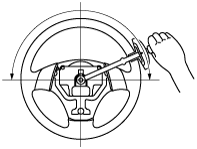STEERING WHEEL AND COLUMN INSPECTION
id061400800300
Play Inspection
1. With the wheels in the straight-ahead position, start the engine.
2. Turn the steering wheel to the left and right gently, then measure the steering wheel play.
-
Standard
-
0—30 mm {0—1.18 in} (oil pressure applied)
Looseness, Excessive Play Inspection
1. Inspect the steering wheel for the following items while moving it in the axial direction and sideways.
-
• If there is any malfunction, replace the applicable part.
-
― Looseness of the steering wheel installation part
― Looseness of the column installation area
― Column bushing wear
― Excessive play of the column bearing
― Excessive play of the steering shaft universal joint
Steering Wheel Effort Inspection
1. Inspect the following.
-
• Tire size and tire pressure
• Fluid level
• Drive belt deflection
2. With the vehicle on a hard, level surface, put the wheels in the straight-ahead position.
3. Remove the air bag module.
-
Warning
-
4. Start the engine, turn the steering wheel to the left and right to make the power steering fluid rise to the suitable temperature (50—60 °C {122—140 °F}).
-
Caution
-
• Do not maintain the steering wheel fully turned for 5 s or more. It is possible that oil temperature can rise, and this will negatively affect the oil pump.
5. Measure the steering wheel effort using a torque wrench.
-
• If not within the reference value, inspect the following:
-
― No air in the steering system
― No fluid leakage from hoses or connectors
― Function of the oil pump and steering gear
-
Steering wheel effort
-
7.8 N·m {80 kgf·cm, 69 in·lbf} or less (Reference value)
-
Note
-
• To determine whether the steering effort is satisfactory or not, perform the inspection on another vehicle of the same model and under the same conditions, and compare the results.
• The steering wheel effort varies with conditions as shown below.
-
― Road conditions: such as dry or wet, and asphalt or concrete
― Tire conditions: such as brand, wear, and tire pressure
